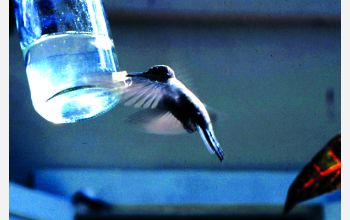Multimedia Gallery
Rufous-breasted hermit hummingbird
A rufous-breasted hermit hummingbird (Gluacis hirsute) feeds at a sugar water bottle (24 percent sugar in sterile boiled water) at the Natural Museum of Museu de Biologia Mello Leitão, Espírito Santo, Brazil. It sticks its long tongue through its beak into the bottle (tongue not seen). The birds have a curved beak that fits into the curved flowers they evolved to feed from.
National Science Foundation (NSF)-supported researcher Erich Jarvis of Duke University is studying hummingbirds and their vocal structures. In 2002, Jarvis was awarded the Alan T. Waterman Award, NSF's highest honor for researchers under the age of 35. [See related images, Swallow-tailed hummingbird and White throated hummingbird.]
More about this image
Hummingbirds have developed a wealth of intriguing features such as backwards flight, ultraviolet vision, extremely high metabolic rates, nocturnal hibernation, high brain-to-body size ratio and a remarkable species-specific diversity of vocalizations.
Like humans, they have also developed the rare trait of vocal learning, the ability to acquire vocalizations through imitation rather than instinct. Vocal learning is known to be present in only six groups of animals--three groups of birds (parrots, songbirds and hummingbirds) and three groups of mammals (bats, cetaceans [whales/dolphins] and humans). All other groups of animals are thought to produce genetically innate vocalizations. To understand this concept, it is important to distinguish vocal learning from auditory learning. Auditory learning is the ability to make sound associations, such as when a dog learns how to respond to the sound "sit." All vertebrates have auditory learning. Vocal learning is the ability to imitate sounds that you hear, such as a human or a parrot imitating the sound "sit." Currently, only vocal learners have been found to have forebrain regions dedicated to vocal learning and production of these learned vocalizations. Vocal non-learners only have been found to have non-forebrain vocal regions, which are responsible for the production of innate vocalizations.
Jarvis is studying hummingbirds and their vocal structures. Hummingbirds are a particularly good model to study because they have the ability to imitate sounds and pass them down through generations. The objective of Jarvis' study was to determine how the vocal learning behavioral trait and associated brain structures evolved.
Jarvis utilized vocalizing-driven gene expression to identify vocal brain structures in vocal learning and vocal non-learning species. To date, he have used this approach in three vocal learners--songbirds, parrots and hummingbirds--and has found that they each contain seven very similar brain structures. If, according to the current dominant hypothesis, vocal learning evolved independently in all six vocal learning groups within the past 65 million years, then the striking similarities in brain structure of at least the three avian groups suggests there are strong epigenetic constraints on how vocal learning can evolve. Jarvis is trying to determine if this hypothesis is correct, or if there really was a common ancestor with vocal learning and other groups lost them through evolution. (Date of Image: Unknown)
Credit: Picture by Maria Amelia for Dr. Erich D. Jarvis
Images and other media in the National Science Foundation Multimedia Gallery are available for use in print and electronic material by NSF employees, members of the media, university staff, teachers and the general public. All media in the gallery are intended for personal, educational and nonprofit/non-commercial use only.
Images credited to the National Science Foundation, a federal agency, are in the public domain. The images were created by employees of the United States Government as part of their official duties or prepared by contractors as "works for hire" for NSF. You may freely use NSF-credited images and, at your discretion, credit NSF with a "Courtesy: National Science Foundation" notation.
Additional information about general usage can be found in Conditions.
Also Available:
Download the high-resolution TIFF version of the image. (2.1 MB)
Use your mouse to right-click (Mac users may need to Ctrl-click) the link above and choose the option that will save the file or target to your computer.

